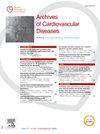Comparison between cardiac magnetic resonance and echocardiography to evaluate risk of post-operative left ventricular dysfunction in primary mitral regurgitation
IF 2.3
3区 医学
Q2 CARDIAC & CARDIOVASCULAR SYSTEMS
引用次数: 0
Abstract
Background
Among patients with primary mitral regurgitation (MR) undergoing mitral valve (MV) surgery, some are at an increased risk of developing postoperative left ventricular (LV) dysfunction. It remains unclear whether CMR-assessed LV volumes and function offer advantages over echocardiographic measurements in identifying patients at risk of LV systolic dysfunction after MV surgery.
Objectives
We sought to compare relations between preoperative LV characteristics assessed by cardiac magnetic resonance imaging (CMR) or echocardiography (Echo) and risk of post-operative LV systolic dysfunction in primary MR patients.
Methods
The study population included 223 patients (median age: 60 years, 21% women) with chronic significant primary MR who underwent Echo and CMR before MV repair surgery. The primary endpoint was post-operative LV dysfunction (LV ejection fraction [EF] < 50%).
Results
Forty-one (18%) patients had post-operative LV dysfunction (median follow-up time 8.7 [IQR: 6.7–12.5] months). These patients exhibited higher LV end-systolic diameters (ESD) and volumes (ESV) (all P ≤ 0.009), lower CMR-LVEF (P = 0.003), and a trend for lower Echo-LVEF (P = 0.072). Optimal threshold values for LV characteristics associated with post-operative LV dysfunction were: LVESD ≥ 36 mm, indLVESD ≥ 19 mm/m2, Echo-indLVESV ≥ 40 ml/m2, Echo-LVEF ≤ 63%, CMR-indLVESV ≥ 45 ml/m2 and CMR-LVEF ≤ 59%. Their AUCs ranged from 0.59 (0.49–0.68) (Echo-LVEF) to 0.70 (0.61–0.78) (Echo-indLVESD), without significant differences in pairwise comparisons (all P > 0.081). A preoperative echocardiographic assessment using combinations of LVESD, indLVESD, Echo-indLVESV, and Echo-LVEF provided similar diagnostic accuracy to a CMR-based assessment using CMR-indLVESV and CMR-LVEF (Figure 1, Figure 2, Figure 3).
Conclusion
In this cohort of patients with significant primary MR undergoing MV surgery, preoperative Echo and CMR LV volumetric and functional characteristics were comparably effective to detect those at higher risk for post-operative LV systolic dysfunction.
心脏磁共振与超声心动图评价原发性二尖瓣反流术后左心室功能障碍风险的比较
背景:在接受二尖瓣(MV)手术的原发性二尖瓣返流(MR)患者中,一些患者术后发生左心室功能障碍的风险增加。目前尚不清楚cmr评估的左室容积和功能是否比超声心动图测量在识别中心室手术后存在左室收缩功能障碍风险的患者方面具有优势。目的:比较术前通过心脏磁共振成像(CMR)或超声心动图(Echo)评估的左室特征与原发性MR患者术后左室收缩功能障碍风险之间的关系。方法研究人群包括223例慢性原发性MR患者(中位年龄:60岁,21%为女性),他们在MV修复手术前接受了Echo和CMR检查。主要终点为术后左室射血分数[EF] <;50%)。结果41例(18%)患者术后出现左室功能障碍,中位随访时间8.7个月(IQR: 6.7 ~ 12.5个月)。这些患者表现出较高的左室收缩期终末直径(ESD)和容积(ESV) (P均≤0.009),较低的CMR-LVEF (P = 0.003)和较低的Echo-LVEF (P = 0.072)。与术后左室功能障碍相关的左室特征的最佳阈值为:LVESD≥36 mm, indLVESD≥19 mm/m2, Echo-indLVESV≥40 ml/m2, Echo-LVEF≤63%,CMR-indLVESV≥45 ml/m2, CMR-LVEF≤59%。他们的auc范围为0.59 (0.49-0.68)(Echo-LVEF)至0.70 (0.61-0.78)(Echo-indLVESD),两两比较无显著差异(P >;0.081)。术前超声心动图评估使用LVESD、indLVESD、Echo-indLVESV和Echo-LVEF的组合与使用CMR-indLVESV和CMR-LVEF的基于cmr的评估提供相似的诊断准确性(图1、图2、图3)。结论在接受中压手术的原发性MR显著患者中,术前回声和CMR左室体积和功能特征对检测术后左室收缩功能障碍高危患者具有相当的有效性。
本文章由计算机程序翻译,如有差异,请以英文原文为准。
求助全文
约1分钟内获得全文
求助全文
来源期刊

Archives of Cardiovascular Diseases
医学-心血管系统
CiteScore
4.40
自引率
6.70%
发文量
87
审稿时长
34 days
期刊介绍:
The Journal publishes original peer-reviewed clinical and research articles, epidemiological studies, new methodological clinical approaches, review articles and editorials. Topics covered include coronary artery and valve diseases, interventional and pediatric cardiology, cardiovascular surgery, cardiomyopathy and heart failure, arrhythmias and stimulation, cardiovascular imaging, vascular medicine and hypertension, epidemiology and risk factors, and large multicenter studies. Archives of Cardiovascular Diseases also publishes abstracts of papers presented at the annual sessions of the Journées Européennes de la Société Française de Cardiologie and the guidelines edited by the French Society of Cardiology.
 求助内容:
求助内容: 应助结果提醒方式:
应助结果提醒方式:


